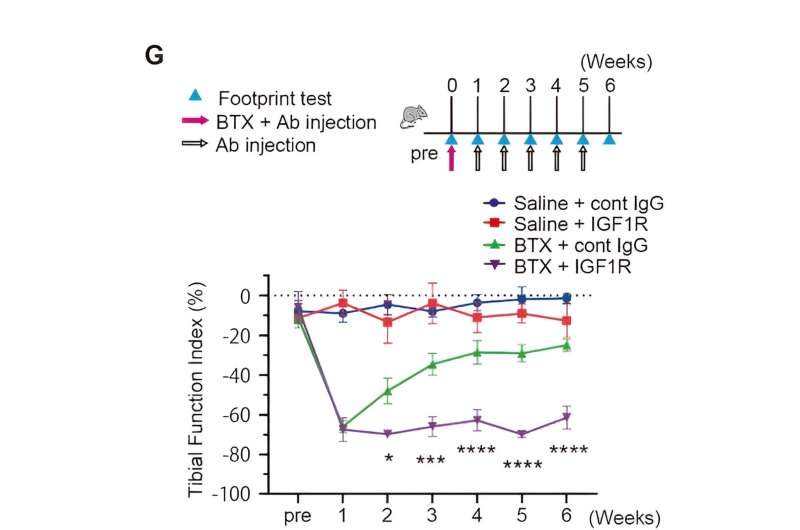This article has been reviewed according to Science X's editorial process and policies. Editors have highlighted the following attributes while ensuring the content's credibility:
fact-checked
proofread
Prolonging the effects of botulinum therapy: A milestone in neuromuscular disease management

Botulinum toxin-A (BTX), also known as Botox, is used to treat a range of neuromuscular disorders, including muscle spasms, dystonia, eye twitching, overactive bladder, and spasticity associated with cerebral palsy or stroke. Notably, BTX has gained popularity in cosmetology owing to its effectiveness in minimizing facial wrinkles. BTX works by inducing paralysis at neuromuscular junctions (NMJs)—the connections between a neuron (brain cell) and a muscle fiber.
However, owing to the gradual recovery of NMJs, BTX has a relatively short duration of action. Patients require repeated BTX injections at short intervals, which limits the accessibility of BTX to patients. Hence, strategies to improve the duration of BTX's therapeutic benefits would be extremely useful.
This feat has now been made possible by a research group led by Prof. Masashi Fujitani from the Department of Anatomy and Neuroscience, Faculty of Medicine, Shimane University, Japan.
In a study published in Cell Death & Disease, the team, which also included Dr. Hiroki Ishihara, Dr. Yoshinori Otani, Dr. Hisao Miyajima, and Dr. Huy Xuan Ngo from Shimane University, demonstrates that the paralytic effect of BTX at the NMJ can be prolonged by specifically blocking the insulin-like growth factor 1 receptor (IGF1R)—a cell surface protein involved in NMJ regeneration.
"Given that BTX specifically targets NMJs, we sought to understand if its paralytic therapeutic effects could be prolonged by preventing NMJ regeneration. To do this, we targeted regenerative factors that support NMJ regeneration and zeroed in on IGF1R," explains Prof. Fujitani.
This study was conducted using a mouse model. Specifically, the researchers focused on the gastrocnemius (GC) muscle in the leg. After BTX treatment, they blocked IGF1R in this muscle using an intramuscular injection of a specific anti-IGF1R antibody. Subsequently, the experimental mice were subjected to a variety of tests, including footprint and gait analysis, to examine the effect of IGF1R blockade. The muscle tissue was also dissected to perform morphological analysis and study changes at the NMJ.
The results of this study showed that blocking IGF1R could slow down recovery from BTX-induced paralysis, thereby extending the therapeutic effects of BTX. This was accompanied by biological alterations at the NMJ.
On exploring the molecular mechanisms underlying this effect, the researchers found that NMJ regeneration following BTX treatment was mediated by translation signaling via the mTOR/S6 kinase signaling pathway, which is the key controller of mammalian metabolism and physiology. However, anti-IGF1R antibodies inhibited this pathway, thereby impairing regeneration and prolonging the therapeutic benefits of BTX.
To Prof. Fujitani and the rest of his research group, these results signify a major milestone in BTX therapy and herald a bright future for the management of neuromuscular disorders.
"In clinical settings, IGF1R inhibition could decrease the number of injections and the total dose of BTX necessary by prolonging the duration of its effects. This would be especially crucial in the areas of rehabilitation and cosmetic therapy, where patients seek sustained results. We are now looking at a significant reduction in the cost and burden of BTX, which can impact a large group of patients," comments Prof. Fujitani.
Indeed, the new BTX therapy in combination with anti-IGF1R treatment could provide more long-lasting results, allowing patients to experience prolonged benefits. It could reduce the number of BTX treatment sessions required, making the treatment more cost-effective, reducing hospital visits, and potentially increasing patient convenience and adherence. Most importantly, it provides a major source of hope for the many patients who may benefit from it in the future.
More information: Hiroki Ishihara et al, Blocking insulin-like growth factor 1 receptor signaling pathway inhibits neuromuscular junction regeneration after botulinum toxin-A treatment, Cell Death & Disease (2023). DOI: 10.1038/s41419-023-06128-w





















